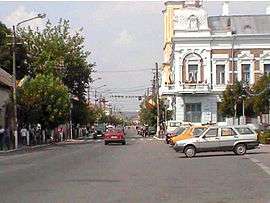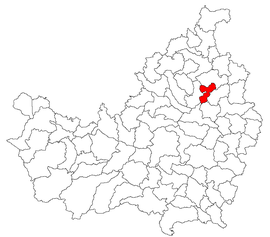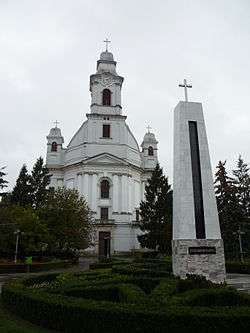Gherla
Gherla (Romanian pronunciation: [ˈɡerla]; Hungarian: Szamosújvár; German: Neuschloss) is a municipality in Cluj County, Romania (in the historical region of Transylvania). It is located 45 km from Cluj-Napoca on the river Someșul Mic, and has a population of 20,203. Three villages are administered by the city: Băița (formerly Chirău, and Kérő in Hungarian), Hășdate (Szamoshesdát) and Silivaș (Vizszilvás).
Gherla | |
|---|---|
 | |
 Coat of arms | |
 Location in Cluj County | |
 Gherla Location in Romania | |
| Coordinates: 47°1′12″N 23°54′0″E | |
| Country | |
| County | Cluj |
| Government | |
| • Mayor | Ioan Neselean[1] (PSD) |
| Area | 36.3 km2 (14.0 sq mi) |
| Population (2011)[2] | 20,982 |
| • Density | 580/km2 (1,500/sq mi) |
| Time zone | EET/EEST (UTC+2/+3) |
| Vehicle reg. | CJ |
| Website | www |
The city was formerly known as Armenopolis[3] (Armenian: Հայաքաղաք Hayakaghak; German: Armenierstadt; Hungarian: Örményváros) because it was populated by Armenians.[4]
History
| Year | Pop. | ±% |
|---|---|---|
| 1910 | 6,857 | — |
| 1930 | 6,608 | −3.6% |
| 1948 | 6,663 | +0.8% |
| 1956 | 7,617 | +14.3% |
| 1966 | 12,766 | +67.6% |
| 1977 | 17,599 | +37.9% |
| 1992 | 26,277 | +49.3% |
| 2002 | 24,232 | −7.8% |
| 2011 | 20,982 | −13.4% |
| Source: Census data | ||
A clay tablet containing a fragmentary Old Persian cuneiform of the Achaemenid king Darius I was found at Gherla in 1937. It may be connected to Darius I's epigraphic activities in relation to his Scythian campaign of 513 BC as reported by Herodotus.[5][6][7]
The locality was first recorded in 1291 as a village named Gherlahida, (probably derived from the Slavic word grle, meaning "ford"). The second name was Armenian, Հայաքաղաք Hayakaghak, meaning "Armenian city"; it took the Medieval Latin and Greek official name Armenopolis, as well as the German alternative name Armenierstadt. Later, the name Szamosújvár was used in official Hungarian records, meaning "the new town on the Someș". Before 1918, Gherla was part of the Kingdom of Hungary comitatus of Szolnok-Doboka. It was again part of Hungary between 1940–1944.
The modern city was built in the early 18th century by Armenians, successors of the Cilician Armenian diaspora, who had originally settled in Crimea and Moldavia, and moved to Transylvania sometime after 1650. After a two years' campaign by the Armenian-Catholic Bishop Oxendius Vărzărescu, they converted from the Armenian Apostolic Church to the Armenian Catholic Church.
Gherla is the seat of the Ordinariate for Catholics of Armenian Rite in Romania, as well as that of a Greek-Catholic diocese – the Cluj-Gherla Diocese (suffragan to the Greek-Catholic Archbishop of Alba Iulia and Făgăraș-Blaj, who resided in Blaj). In the center of the city lie the Saint Gregory the Illuminator and the Holy Trinity Armenian Cathedral. The main Armenian-Catholic church was built in 1792. The Greek Catholic diocese was created by the Papal Bull Ad Apostolicam Sedem of November 26, 1853, and the first bishop was Ioan Alexi.
A Habsburg fortress was built here and converted to a prison in 1785. During the Communist regime, the prison was used for political detainees (see Gherla prison). Today it is a Romanian high-security prison.
The town is often visited by Orthodox pilgrims on their way to the nearby village of Nicula and Nicula Monastery.
Gherla also had a significant Jewish population which was decimated during the Holocaust. After the war most of the remaining Jewish population left the city. The Synagogue and the Holocaust Memorial Monument are visited by tourists from many countries.
Population
According to the 2011 Romanian census, there were 20,982 people living within the city, as follows:[8]
- 15,952 (76.0%) Romanians
- 3,435 (16.4%) Hungarians
- 735 (3.5%) Roma
- 61 (0.3%) others, including 16 Germans
Natives
References
- "Results of the 2016 local elections". Central Electoral Bureau. Retrieved 3 April 2020.
- "Populaţia stabilă pe judeţe, municipii, oraşe şi localităti componenete la RPL_2011" (in Romanian). National Institute of Statistics. Retrieved 4 February 2014.
- Mallows, Lucy (2008). Transylvania. Chalfont St. Peter: Bradt Travel Guides. p. 256. ISBN 9781841622309.
- Steve Kokker, Cathryn Kemp (2004). Romania & Moldova. Footscray, Victoria: Lonely Planet. p. 159. ISBN 9781741041491.
Gherla Once a predominantly Armenian settlement called Armenopolis in the 17th century...
- Kuhrt 2013, p. 197.
- Frye 1984, p. 103.
- Schmitt 2000, p. 53.
- Tab8. Populaţia stabilă după etnie – judeţe, municipii, oraşe, comune, 2011 census results, Institutul Național de Statistică, accessed 17 February 2020.
Sources
- Kuhrt, A. (2013). The Persian Empire: A Corpus of Sources from the Achaemenid Period. Routledge. ISBN 978-1136016943.CS1 maint: ref=harv (link)
- Frye, Richard Nelson (1984). Handbuch der Altertumswissenschaft: Alter Orient-Griechische Geschichte-Römische Geschichte. Band III,7: The History of Ancient Iran. C.H.Beck. ISBN 978-3406093975.CS1 maint: ref=harv (link)
- Schmitt, Rüdiger (2000). The Old Persian Inscriptions of Naqsh-i Rustam and Persepolis. Corpus Inscriptionum Iranicarum by School of Oriental and African Studies. ISBN 978-0728603141.CS1 maint: ref=harv (link)
External links
| Wikimedia Commons has media related to Gherla. |
- Armenierstadt

- Armenians in Romania at the Central European University site

